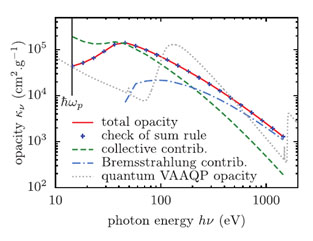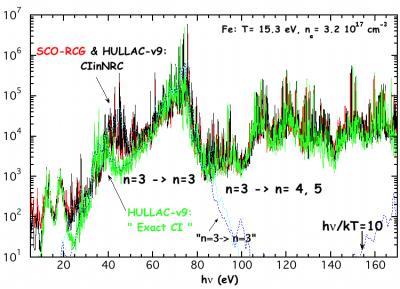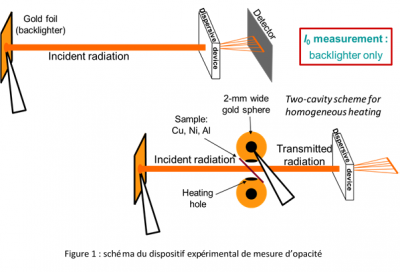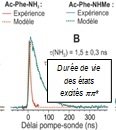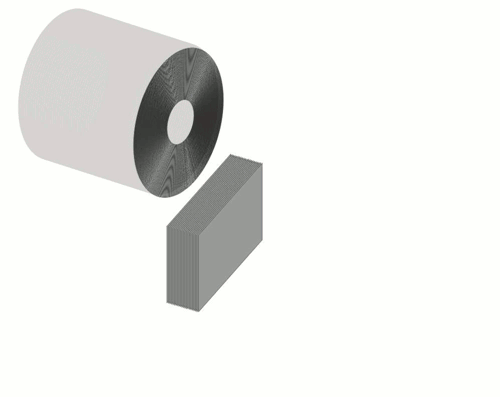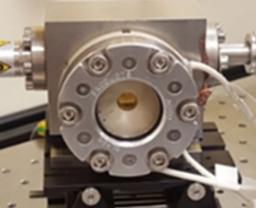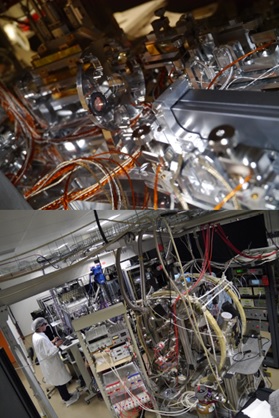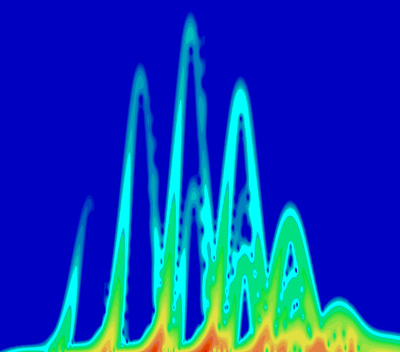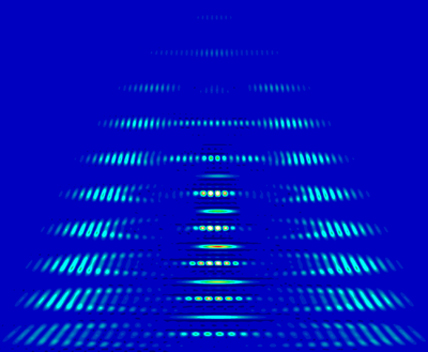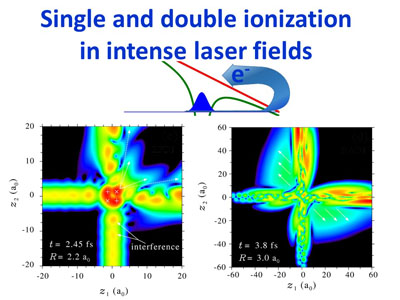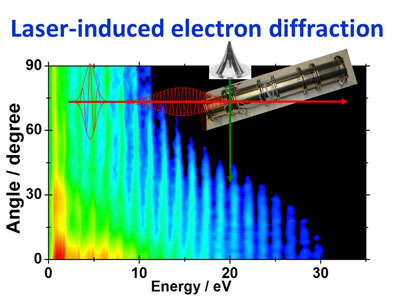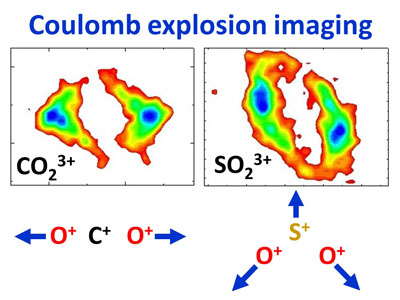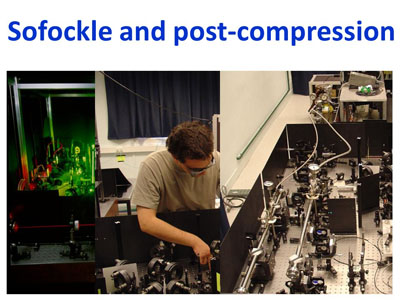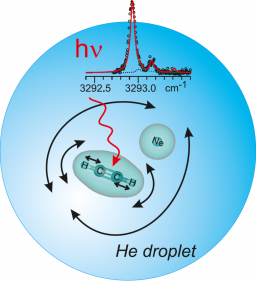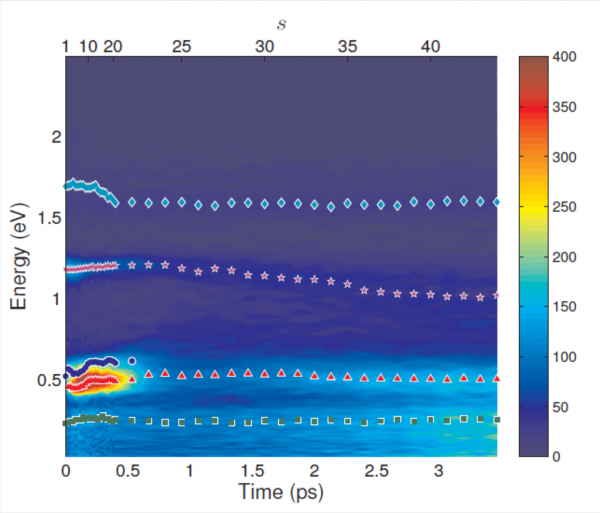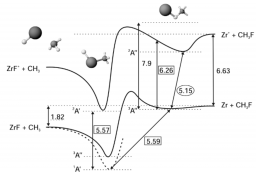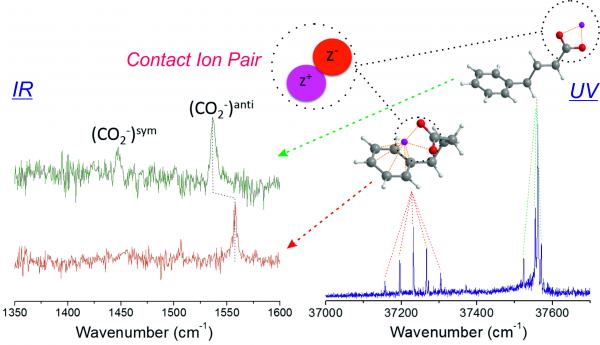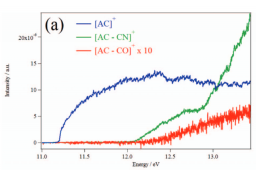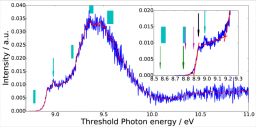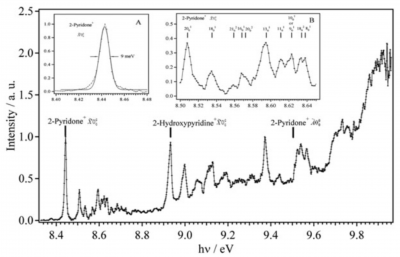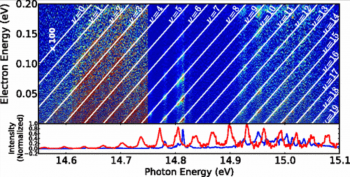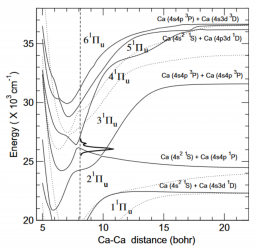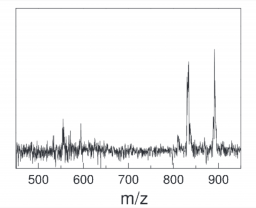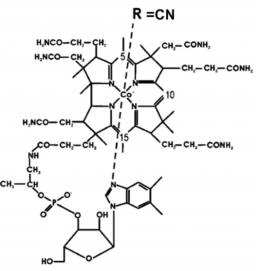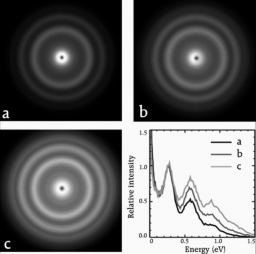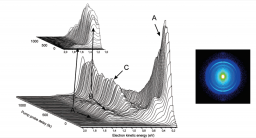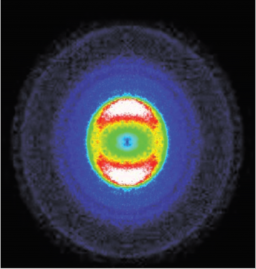2018
Différents types de filtres sont élaborés au LEDNA :
Filtres-concentrateurs ou filtres spécifiques de piégeage. Les premiers sont déposés sous forme de films minces nanoporeux sur divers capteurs , comme des capteurs à onde acoustique (SAW) ou des capteurs résistifs à base de nanotubes de carbone (NTC). Ainsi, pour la détection du formaldéhyde avec les capteurs SAW, la taille des nanopores du matériau est comprise entre 0.8 et 2 nm et la surface du film est fonctionnalisée avec des groupements amine pour retenir et concentrer CH2O aux dépens des molécules de plus grande taille. Pour la détection du benzène avec les capteurs NTC, le matériau nanoporeux comporte des groupements phényle favorisant les interactions π-π* entre cycles aromatiques. Grâce au revêtement de filtre-concentrateur, le capteur SAW peut détecter 80 ppb de CH2O et le capteur NTC quelques dizaines de ppb de benzène dans l’air.
Des filtres colorimétriques ont été développés pour le piégeage spécifique du formaldéhyde, de la trichloramine et de l’ozone. Les réactions colorimétriques mises en jeu dans les pores des matériaux et l’évolution de la coloration en fonction de la durée d’exposition aux polluants permettent de contrôler l’état de saturation des filtres. Ces réactions sont les suivantes pour CH2O, NCl3 et O3 :
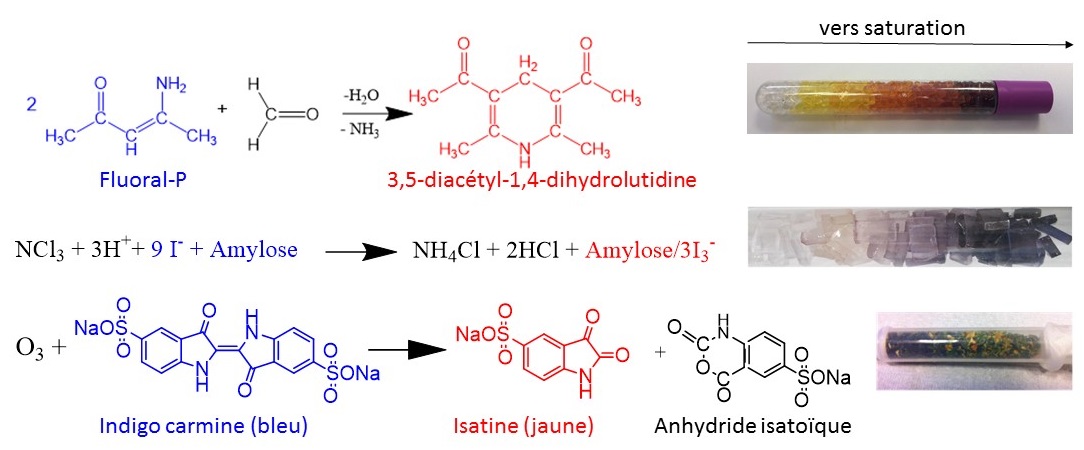
On peut noter que l'intercalation d'un filtre de O3 en amont d'un capteur à base de semiconducteur (WO3) sensible à la fois à O3 et NO2 permet la mesure sélective de NO2.
Filtration en milieu liquide : Outre la filtration sélective en milieux gazeux, le LEDNA s’intéresse également à la dépollution de l’eau avec la mise en œuvre de nouveaux matériaux composites de type cœur-coquille, CA@F-SiO2, à base de charbon actif (CA) et de nanoparticules silicatés fonctionnalisés (F-SiO2). Ces matériaux composites offrent de nouvelles propriétés de piégeage supérieures à celles du mélange des composés inviduels CA et F-SiO2. CA@F-SiO2 piège aussi bien les pesticides et herbicides que CA seul, et montre une bien meilleure efficacité de piégeage pour les petites molécules polaires tels que l’acétone ou l’acétaldéhyde.

à droite : comparaison des performances de piégeage de l’acétone en milieu liquide
avec divers CA-F-SiO2, CA et SiO2 seuls ainsi que leur mélange CA+SiO2.
Références :
M. Othman, C. Théron, M. Bendahan, L. Caillat, C. Rivron, S. Bernardini, G. Le Chevallier, E. Chevallier, M.-P. Som, K. Aguir and T.-H. Tran-Thi, Selective detection of NO2 with specific filters for O3 trapping, Sensors & Actuators B, 2018, 265, 591-599.
M. Vanotti, C. Theron, S. Poisson, V. Quesneau, M. Naitana, V. Soumann, S. Brandès, N. Desbois, C. Gros, T-H. Tran-Thi, V. Blondeau-Patissier, Surface Acoustic Wave Sensors for the Detection of Hazardous Compounds in Indoor Air, Eurosensors, Proceedings 2017, 1,444.
Une connaissance précise des spectres d’absorption de la lumière, ou «opacité spectrale», ainsi que des moyennes de Rosseland (KR) et de Planck (KP) de ces spectres, est fondamentale pour la détermination des évolutions séculaires des étoiles pulsantes. Le calcul de ces données, qui régissent le transport d’énergie par les photons, est complexe, car la contribution des ions semi-lourds de la série du fer présents dans le plasma d’hydrogène et d’hélium constituant les enveloppes stellaires, ne peut être négligée. En effet il est bien établi que les étoiles β Cepheï pulsent par le κ méchanisme dû à une bosse dans l’opacité des éléments autour du fer contenus dans l’enveloppe. Les principales contributions proviennent des éléments : Cr, Fe, Ni, Cu, autour des conditions : logT~5.3 (~20 eV) and ρ~0.1-10 e-6 g/cm³. A ces températures et densités, l’ionisation de ces éléments est telle que, même présents en faible proportion par rapport au mélange d’hydrogène et d’hélium, les myriades d’intenses transitions de couche M ouverte (n=3, Δn=0, 1, 2, ...) constituent une partie importante du spectre de l’opacité. De ce fait elles contribuent de façon notoire tant au calcul du spectre en fréquence, qu’aux moyennes KR et KP. Or des différences ont été constatées entre les données d'opacité OP (1) et OPAL96 (2) accessibles aux astrophysiciens (3).
L’essentiel de la théorie du calcul des opacités à l’Equilibre Thermodynamique Local (ETL) est désormais bien établi et de nombreux codes de par le monde sont maintenant en mesure de fournir des spectres d’opacité spectrale permettant de faire des prédictions ou des interprétations d’expériences (4). Toutefois le traitement « exact » de l’interaction entre les configurations électroniques, appelé Interaction de Configuration (IC), a été identifié comme la principale source de différences entre les plus récents résultats d’opacités de couche M disponibles dans la communauté académique et accessibles aux astrophysiciens. La raison en est que cela conduit très vite à des calculs très « lourds », en temps de calcul et en place mémoire, et souvent impossibles, car la prise en compte des effets de l’IC ne peut se faire que conjointement à une bonne représentation des états excités. C’est pourquoi la plupart des calculs s’appuient sur une ou plusieurs hypothèses simplificatrices pour l’IC afin de pouvoir traiter la globalité du spectre. Nous avons montré récemment que ce processus, qui modifie l’énergie et l’intensité des raies les plus intenses (n=3-> n=3, n=3-> n=4), ne peut être négligé pour ces transitions dans le calcul des opacités spectrales de couche M des éléments de la série du fer (5).
Pour cela nous avons utilisé le code d’opacité Hullac-v9 (6), une version récente du code Hullac, largement réécrit pour être adapté à de tels calculs. Hullac-v9 est maintenant en mesure de fournir des opacités spectrales de couche M ouverte, avec une très grande précision, pour des conditions de plasma typiques d’enveloppes stellaires de faible densité ou de plasmas de laboratoire plus denses. Nous avons effectué de tels calculs pour le chrome, le fer, le nickel et le cuivre. Nous avons largement exploré l’étude de la prise en compte de l’IC sur le pic le plus intense (transitions n=3-> n=3). Hullac-v9 donne la possibilité de choisir le traitement de l’IC désiré : un traitement « exact ou full CI» ou différentes approximations (les modes CIinNRC, CIinLayzer, NoCI,..). Des comparaisons sont donc possibles entre les modes ainsi qu’avec d’autres codes afin de valider nos résultats ou d’évaluer quantitativement les effets de l’IC (7). Les comparaisons effectuées (10-40 eV, 1-10mg/cm3) prédisent des corrections allant entre 10 à 25 % sur les moyennes KR et KP pour les états de charge les plus sensibles (7). Nous avons poursuivi l’étude des transitions plus excitées Δn=1, 2. De tes calculs peuvent facilement atteindre 6 mois et plus et des tailles mémoires considérables, par exemple pour les ions FeVI, FeVII ou NiVIII, NiIX. La convergence des résultats nécessite un compromis entre un bon traitement de L’IC conjointement à une bonne représentation des états excités. A des centaines de milliers de niveaux (qui entraine la diagonalisation de très grandes matrices) sont associés des milliards de coefficients d’interaction à traiter. Des travaux sont en cours pour compléter le travail sur les transitions Δn=0. L’ensemble de ces résultats a été comparé à d’autres calculs d’opacités théoriques (OP (1), les codes ATOMIC de Los Alamos (8, 9), le code TOPAZ (10) ou le code SCO RCG du CEA-DAM (11)). Nous avons mis en évidence et expliqué des résultats aberrants dans la base de données OP remise en cause par les astrophysiciens. Un très bon accord a été observé avec SCO-RCG et une collaboration est en cours pour combiner les performances des 2 codes (5). Des comparaisons ont aussi été réalisées avec les résultats expérimentaux obtenus au LULI avec le laser LULI 2000, pour des conditions de degré de charge (températures entre 10 et 40 eV mais des densités réalisables en laboratoire entre 1 et 5 mg/cm3 (12).
En conclusion le calcul des spectres de couche M ouverte à l’ETL des ions de la série du fer n’est désormais plus un challenge que les théoriciens ne puissent défier grâce à la puissance des ordinateurs de calcul actuels. Toutefois ces calculs nécessitent encore du temps et un grand espace de stockage pour les résultats. La précision obtenue permet la prévision d’expériences. Nous restons dans l’attente de plus de résultats expérimentaux pour valider nos prédictions théoriques.
Références :
- (1) M.J., Seaton, R.M. Badnell, Mon. Not. R. Astron. Soc. 354, 457 (2004); M.J. Seaton & al Mon. Not. R. Astron. Soc. 354, 457 (2004); http://cdsweb.u-strasbg.fr/topbase/.
- (2) C.A. Iglesias, F.J. Rogers, Ap. J. 464, 943 (1996); F.J. Rogers, C.A. Iglesias, Science 263, 50 (1994); C.A. Iglesias, F.J. Rogers and B.G. Wilson, Ap. J. 360, 221 (1990); C.A. Iglesias, F.J. Rogers, Ap. J. Suppl. Ser. 79, 507 (1992); C.A. Iglesias, F.J. Rogers, Ap. J. 443, 469 (1995).
- (3) S. Salmon, S. Montalban, J. Morel et al., Mon. Not. R. Astron. Soc. 422, 3460 (2012); A.A. Pamyatnykh, Acta Astron. 49 (1999) 119; P. Walczak, J. Daszynska-Daszkiewicz, A.A. Pamyatnykh, T. Zdravkov, Mon. Not. R. Astron. Soc. 432, 822 (2013); J. Daszynska-Daszkiewicz, W. Szewczuk, P. Walczak,, Mon. Not. R. Astron. Soc. 431, 3396 (2013); S. Turck-Chièze S., F. Delahaye F., D. Gilles D., et al., High Energy Density Physics 5, 132 (2009) and references therein; S. Turck-Chièze, D. Gilles, M. Le Pennec et al., High Energy Density Physics 9, 243 (2013).
- (4) D. Gilles, S. Turck-Chièze, M. Busquet, F. Thais, G. Loisel, L. Piau, J.E. Ducret, T. Blenski, P. Cossé, G. Faussurier, F. Gilleron, J.C. Pain, J.A. Guzik, D.P. Kilcrease, N.H. Magee J. Harris S. Bastiani-Ceccotti, F. Delahaye and C.J Zeippen, EAS Publications Series 58, 51 (2012); D. Gilles, S. Turck-Chièze, M. Busquet, F. Thais, G. Loisel, L. Piau, J.E. Ducret, T. Blenski, C. Blancard, P. Cossé, G. Faussurier, F. Gilleron, J.C. Pain, Q. Porcherot, J.A. Guzik, D.P. Kilcrease, N.H. Magee J. Harris S. Bastiani-Ceccotti, F. Delahaye and C.J Zeippen, EPJ Web of Conferences 59, 14003, (2013).
- (5) D. Gilles, M. Busquet, M. Klapisch, F. Gilleron, J.-C. Pain, HEDP 16, 1 (2015).
- (6) M. Busquet, M. Klapisch, , D. Gilles, EPJ Web of Conferences 59, 14004 (2013); M. Busquet, A. Bar-Shalom, M. Klapisch, J. Oreg , J. Phys. IV 133, 973 (2006); M. Busquet, M. Klapisch, Bull. American Phys. Soc. 55, 225 (2010); A. Bar-Shalom & al, Phys. Rev. A 40 3183 (1989); ibid, AIP Conference V 926, 206 (2007).
- (7) D. Gilles, M. Busquet,, F. Gilleron, M. Klapisch, J.-C. Pain, Journ of Phys.: Conf. Series 717, 012017 (2016).
- (8) N.H. Magee et al., Astron. Soc. of the Pacific Conf. series, Vol. 78, 51 (1995); J. Colgan et al., International conference on Atomic and Molecular Data Proceedings 17 (2013); J. Colgan et al., High Energy Density Physics 9, 369 (2013)
- (9) C.J. Fontes, C.L. Fryer, A.L.Hungerfold, P. Hakel, J. Colgan, D.P. Kilcrease, M.E.Sherill, American Institute of Physics conference series HEDP 16, 53 (2015).
- (10) C.A. Iglesias, MNRAS 450, 2 (2015).
- (11) J.-C. Pain, F. Gilleron, Q. Porcherot, T. Blenski, Processes in Plasmas conference, Auburn, AL, USA, submitted to AIP Conf. Proc. (2013); J.-C. Pain, F. Gilleron, Q. Porcherot, T. Blenski, Proceedings of the 40th EPS conference, on Plasma Physics, Proceedings of the 40th EPS conference on Plasma Physics P4.403 (2013); Q. Porcherot, J.-C. Pain, F. Gilleron, T. Blenski , High Energy Density Physics 7, 234 (2011); R.D. Cowan, “The Theory of Atomic Structure and Spectra”, University of California Press, Berkeley (1981).
- (12) M. Dozières, F. Thais, S. Bastianni-Cicotti, T. Blenski, M. Comet, F. Condamine, J. Fariaut, F. Gilleron, D. Gilles, J.-C. Pain, M. Poirier, C. reverdin, F. Rosmej, V. Silvert, G. Soullié, B. Villette, HEDP (soumis 2018).
The experiments described here were carried out on the LULI 2000 laser installation. They consist in creating a plasma by indirect heating on a target (usually metallic) and probing it in the X or extreme-UV (XUV) domain by a broadband beam named “backlighter”. The target transmission is measured either in X-ray range, namely from 700 eV to 1800 eV, or in XUV range, from 50 eV to 250 eV approximately. The heating conditions and the electronic density of the plasma are such that local thermodynamic equilibrium assumption is reasonable.
About ten opacity measurement campaigns have been carried out by our team over the last decades using various indirect heating schemes. The first experiments were done with the sample glued to the aperture of the gold sphere used for heating [Thais2003, Loisel 2009]. Then we have used a geometry where a second gold sphere was added symmetrically to the first one with respect to the sample. The detection axis coincided with the line passing through the center of the spheres. As a result the “parasitic” self-emission of the cavities was detected simultaneously with the radiation transmitted by the sample. To prevent this, a third geometry has been elaborated. During recent campaigns the detection has been done either in the X-ray range, or simultaneously in the X-ray and XUV range.
2013 campaign
This campaign was aimed at studying the absorption of nickel, copper and aluminum in the X-ray and XUV domains. Only the results in X-ray range have proved to be usable and are presented here. A typical transmission measurement scheme is shown in Fig. 1.
This part of our activity is theoretical and computational in nature. It concerns low-density plasmas — density of the order of 1/100th of that of the solid or below — in which the interaction between ions can be treated as a perturbation, or even totally neglected. Conversely, this approach applies to very hot plasmas — temperatures between one thousand and one million K — in which the ions may have several open subshells and the absorption spectra a very large number of lines. The purpose of this approach is to describe in detail atomic structure and transition rates. In the present context, the effects of the plasma environment are, if they are taken into account, treated in a perturbative way thanks to a phenomenological term added to the electron-ion interaction Hamiltonian.
A part of this work is done in a completely analytical way. This is particularly the case of the study of the effect of an ionic sphere potential called “uniform electron gas” on the hydrogen-like ions. It is also the case of the study of the configuration-average of the spin-orbit interaction, for which we have developed methods based on the explicit expression of this potential and on the second quantization.
However most of this activity is performed using atomic structure codes available in the literature. These include the HULLAC [BarShalom2001, Busquet2006] and FAC [Gu2008] parametric potential codes that are well suited to the description of highly ionized plasmas. The source code is in both cases available, which allows us if necessary to add new effects, such as the interaction via an ion-sphere potential. However, most of our work consists in writing post-processors that allow us to calculate the plasma spectra at the thermodynamic equilibrium, or to characterize the properties of plasmas outside thermodynamic equilibrium. We also make comparisons with the SCO-RCG hybrid code developed partly in our laboratory and partly at the CEA-DAM [Porcherot2011]. This numerical approach described above applies essentially to three types of studies.
1. Laser-plasma interaction experiments performed on kJ (LULI 2000) class facilities producing nanosecond pulses are interpreted using post-processors developed in our laboratory. These are based on the hypothesis of a plasma at local thermodynamic equilibrium (LTE) and weakly correlated.
2. We develop so-called “collisional-radiative” codes to study low-density and non-LTE plasmas, which are based on data produced by the HULLAC or FAC suites.
3. Effects related to the plasma environment are treated with an additional term in the electron-ion-interaction in the ion-sphere hypothesis. This term may be included in the FAC code. It describes the screening effect associated with free electrons. It allows us to calculate level shifts and changes in transition or collision rates.
Links toward subtopics :
Configuration average and transition arrays
Details codes for Plasma at LTE or non-LTE : interpretations of laser-plasmas experiments
Plasma environments Effects
References :
- [BarShalom2001] A Bar-Shalom, M Klapisch, J Oreg, “HULLAC, an integrated computer package for atomic processes in plasmas”, J. Quant. Spectrosc. Radiat. Transfer 71 169 (2001).
- [Busquet2006] M Busquet, A Bar-Shalom, M Klapisch, “An improved version of the HULLAC code”, J. Phys. IV France 133 973 (2006).
- [Gu2008] M F Gu, “The flexible atomic code”, Can. J. Phys. 86 675 (2008).
- [Porcherot2011] Q Porcherot, J-C Pain, F Gilleron, T Blenski, “A consistent approach for mixed detailed and statistical calculation of opacities in hot plasmas”, High Energy Density Phys. 7 234 (2011).
Les sources d’électrons ont largement été supplantées par les sources de photons dans les applications résolues en temps. Les développements récents de nouvelles sources d’électrons permettent de reconsidérer leur utilisation pour ces applications émergentes. Ces sources possèdent en effet un certain nombre d’avantages : les électrons sont en général plus simples à produire et à manipuler que les RX, avec un rapport performance/prix inégalé. La production et la caractérisation de paquets d’électrons ultracourts constitue aujourd’hui un défi technologique à relever pour s’ouvrir aux domaines applicatifs. Sous l’impulsion d’un groupe d’utilisateurs de la ligne XUV PLFA avec lequel nous avions une collaboration de longue date, (B. Lucas, E-M. Staicu Casagrande, Y. Picard et A. Huetz à l’ISMO, F. Catoire au CELIA, M. Géléoc au LIDYL), une première version de canon à électrons est développée en 2014 par A. Huetz. L’objectif visé est alors l’ionisation en phase gaz par impact d’électrons de molécules alignées par laser sur PLFA, dans le cadre du projet ANR MOLALIE. En 2015, un nouveau projet de recherche PALM EMERGENCE voit le jour avec une nouvelle équipe constituée (port. LIDYL M. Géléoc) : coll. CEA/LIDYL (D. Guillaumet, T. Gustavsson), CEA/NIMBE (JP. Renault, M. Bouhier), ISMO (EM Staicu-Casagrande), LPGP (B. Lucas) et la start-up iTEOX (T. Oksenhendler). Les finalités scientifiques sont différentes mais basées sur l’utilisation d’un outil commun : un canon à électrons photo-déclenché par laser. Dans LUBIOL, nous étudions à l’aide de ce canon la scintillation de molécules biologiques résolue en temps, induite par des paquets d’e- ultra-courts. Une publication est en cours de rédaction.
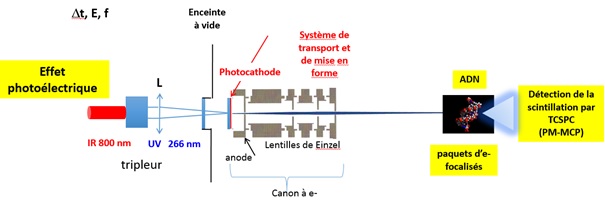
Schéma de principe de l’expérience LUBIOL
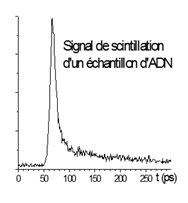
1ère mesure de scintillation à résolution temporelle picoseconde de l’ADN
Ce projet a bénéficié du soutien du réseau RENATECH

Les molécules flexibles présentent des propriétés variant suivant leur forme, ce qui en fait des objets dont les applications intéressent de multiples domaines (médicaments, nouveaux matériaux, foldamères…). Un des enjeux majeurs est de pouvoir contrôler leur repliement et in fine de contrôler leurs propriétés. Dans ce contexte, de nombreuses techniques existent pour caractériser les différentes conformations que peuvent adopter ces molécules flexibles. Parmi elles, la spectroscopie IR a été employée pour caractériser les diverses conformations adoptées par une fonction chimique très appréciée dans la synthèse de molécules flexibles de forme contrôlée, la fonction hydrazide. Cette étude impliquant l’équipe SBM du LIDYL, en collaboration avec deux équipes de l’Université Paris-Sud, a montré que cette spectroscopie était extrêmement sensible aux effets d’hyperconjugaison se produisant au cœur des hydrazides, procurant ainsi un puissant diagnostic conformationnel.
Référence : "Direct Spectroscopic Evidence of Hyperconjugation Unveils the Conformational Landscape of Hydrazides", E. Gloaguen, V. Brenner, M. Alauddin, B. Tardivel, M. Mons, A. Zehnacker-Rentien, V. Declerck, D. J. Aitken. Angew. Chem. Int. Ed. 10.1002/anie.201407801.L’hyperconjugaison, c’est-à-dire le transfert électronique partiel entre orbitales voisines (délocalisation), est en effet un phénomène extrêmement général, qui contribue notamment à stabiliser les conformations des systèmes flexibles, et dont la mise en évidence expérimentale directe restait jusqu’à présent très limitée. En parvenant à détecter l’hyperconjugaison sur des hydrazides, la spectroscopie IR ouvre ainsi des perspectives non seulement pour la caractérisation des conformations de nombreux systèmes flexibles, mais aussi pour l’étude plus fondamentale du concept d’hyperconjugaison et de sa modélisation
Suite à l'absorption UV, de nombreux systèmes biomoléculaires sont dotés de mécanismes de désactivation des états excités qui assurent leur stabilité photochimique. L'un des principaux objectifs de notre recherche est d'étudier la dynamique conformère-sélective de systèmes moléculaires bio-pertinents par une approche duale expérience-théorie qui consiste en la mise en œuvre :
i) d’une caractérisation expérimentale des durées de vie et de la nature des états électroniques formés dans des expériences pompe-sonde nano, pico- et femtoseconde. Des techniques de diagnostic sophistiquées sont utilisées pour caractériser la dynamique d'état excité.
Contact : V. Brenner, M. Mons
While the absorption of light by molecular systems and in particular biomolecules is ubiquitous in Nature and used in many fields of research, the understanding of the underlying ultrafast process following the photon absorption is still limited. Conformer-selective excited state dynamics of bio-relevant systems (isolated and hydrated peptides, or model complexes for chiral recognition) have been then investigated, in the frame of the ANR-funded ESBODYR project, through a synergetic experimental/theoretical approach :
(i) An original multi-step and multi-level theoretical strategy to efficiently and accurately model the excited states potential energy surfaces of these systems have been developed.
(ii) In parallel, novel experimental procedures coupling the measure of excited state dynamics by nano-, pico and femtochemistry techniques with the conformer-selectivity brought by IR spectroscopy or its variant in helium droplets have been implemented.
Laser spectroscopies & applications
Contacts : E. Gloaguen, M. Mons
|
|
The IR / UV laser spectroscopy conducted in the gas phase (supersonic jet and laser desorption), which the group has significantly contributed to popularize, allows a thorough conformational analysis of the studied systems. Its coupling with quantum chemistry modeling enables to document with precision the intramolecular interactions that stabilize these flexible systems, in particular the intramolecular H-bonds. Thus conformational stabilization by hyperconjugation has been demonstrated (see the dedicated Highlight). The application of the IR / UV technique to systems without UV chromophores has also been documented. |
Contact : M. Géléoc
Canon à électron photo-déclenché par laser à haute résolution temporelle
En nous appuyant sur les résultats du projet LUBIOL et sur une collaboration avec la start-up iTEOX, nous avons initié des travaux en vue de réaliser un démonstrateur de mini-canon (voir fait marquant).
Objectifs :
- Combler le gap entre les canons commerciaux et les canons de laboratoire
- Générer des impulsions d’électrons ultra-courtes (ps) à l’aide d’un instrument facile d’utilisation
- Etendre le champ d’application de ces impulsions
- Améliorer les performances des mesures résolues en temps
La preuve de concept établie en 2016, nous travaillons depuis à la conception et au développement de prototypes. On peut citer notamment le développement d’outils de caractérisation des impulsions, notamment un nouveau diagnostic temporel picoseconde pour la détection robuste de charges résolue en temps, ainsi que le développement d’un démonstrateur miniaturisé pour l’analyse par faisceau d’électrons. Nous avons un objectif de valorisation et un objectif de recherche portant sur le développement de nouvelles applications dans les domaines de l’interaction électron-matière.
En termes de perspectives de valorisation, un brevet est en cours d’examen et la création d’une start-up, faisant le lien avec un partenaire industriel, est à l’étude. Outil de choix pour des expériences pompe-sonde, le couplage du mini canon avec les sources kHz d’ATTOLab, ou les sources MHz comme SOLEIL sera tenté. L’intégration des différentes briques technologiques développées, dans un nouvel instrument dédié à l’étude de spectres de molécules biologiques, sera notamment poursuivie au sein du groupe LUMO en 2019.
Charged particle acceleration through laser-matter interaction is a well known phenomenon since long-time. It nowadays gains again the attention of a range of not exclusively scientific communities thanks to the advances in high energy lasers technology. In particular, the CPA technique allows T3 (Table Top Térawatt) lasers reaching, and sometimes getting over, intensities around 1020 W/cm2. Particle beams produced in this so-called “relativistic” regime (as accelerated electrons velocity is close to c) show outstanding features in terms of energy, brightness and short burst duration. As a consequence they are interesting for a large spread of applications (electric fields and density probing in plasmas, isochoric heating, positron, neutrons and medical isotopes production, health domain applications). Undoubtedly, the research in this field is stimulated to a large extent by the hope of using laser produced high energy particles for medical purposes. In particular, laser driven sources appear as a quite promising alternative to classical accelerator sources for proton beam therapy.
In Saclay, the PHI group has been working on this theme since 2005, using our ultra-high contrast 100 TW, 25 fs laser system (UHI100). In these conditions of interaction, we were the first to show, in the past, that both the side of the target exposed to the laser and the opposite side produce beams of particles with similar characteristics, which propagate, in directions opposite, normally to the target[1] . Today, our research focuses mainly on the study of the influence of appropriately structured targets (foams, nanostructures, grating-like patterns) on the emitting characteristics of proton beams[2].

|
Figure: Typical interaction scheme for TNSA mechanism (on the left) : when a high intensity laser beam is focused on a thin (~µm) target, a laminar bunch of protons (and other heavier ions) is accelerated from the target rear side. A Thomson parabola diagnostic is commonly used to record and characterize the ion emission ((on the right) . |
References :
[1] Proton Acceleration with High-Intensity Ultrahigh-Contrast Laser Pulses
T. Ceccotti, A. Lévy, H. Popescu, F. Réau, P. D’Oliveira, P. Monot, J. P. Geindre, E. Lefebvre, and Ph. Martin
PHYSICAL REVIEW LETTERS, 99, 185002 (2007)
[2] Energetic ions at moderate laser intensities using foam-based multi-layered targets
Passoni, M.; Zani, A.; Sgattoni, A.; et al. PLASMA PHYSICS AND CONTROLLED FUSION, 56, (2014)
Evidence of Resonant Surface-Wave Excitation in the Relativistic Regime through Measurements of Proton Acceleration from Grating Targets
Ceccotti, T.; Floquet, V.; Sgattoni, A.; et al. PHYSICAL REVIEW LETTERS, 111, 185001 (2013);
Micro-sphere layered targets efficiency in laser driven proton acceleration
Floquet, V.; Klimo, O.; Psikal, J.; et al, JOURNAL OF APPLIED PHYSICS, 114, 083305 (2013)
|
Like any massive particle, photons may carry both a spin and an orbital angular momentum. The former is associated to the circular polarisation of a light beam, while the latter is associated to an helicoidal wavefront ( see for instance the review by A. M. Yao and M. J. Padgett). These two types of beams find applications in different situations. In particular, while the spin projection along the propagation axis for paraxial beams is limited to two values,
|
 |
|
Post-shaping XUV radiation High Harmonic Generation delivers a very wide spectrum of harmonics in the XUV range, made of a comb of the odd harmonics of the driving laser. Each individual harmonic lasts a fraction of the duration of the driving laser and is all the broader as the driving laser has a short duration. With ultimate single or few cycles driving pulses, it converges to a continuum spectrum, where several harmonics overlap spectrally and finally merge together. In the 10 kHz experimental room at Attolab, we designed a steady beamline to “post-shape” this harmonic beam, before delivering it through a free port available for external users. In brief we offer three working mode, with durations from about 100 as up to 10 fs, synchronized with a pump of 23 fs duration at λ =800 nm.This flexibility is achieved by inserting different XUV optics on the beam path. Switching from one mode to another takes about 15 minutes. This new equipment is being commissioned in 2018. Further information : attolab.fr People : David Bresteau, Carlo Spezzani, Julien Lenfant, David Denettierre (Soleil), François Pollack (Soleil), Maël Delhinger (IOGS), Franck Delmotte (IOGS), Thierry Ruchon (task leader). Funding : Equipex Attolab, coordinated by Bertrand Carré at LIDYL. Satellite projects : Opt2X from Paris-Saclay (coordination Danielle Dowek, Marino Marsi), Attolite (Coordination Pascal D’Oliveira at LIDYL) and Pulse-X (Coordination Danielle Dowek) from region Ile de France. |
|
Throughout the development of ultrafast optics, the ability to accurately measure the temporal properties of ultrashort light pulses has been crucial. Several well-established techniques are now available to measure their electric field E(t) from the femtosecond down to the attosecond range. However, within any ultrashort beam, the temporal properties of the light pulse can vary spatially and vice versa.
Such correlations between the spatial and temporal properties are called spatiotemporal couplings (STCs) and prevent the decomposition of the laser field E(t,r) as E(t,r) = f(t)g(r). A simple Fourier transform with respect to time shows that STCs are the temporal counterpart of conventional chromatism, that is, the frequency dependence of the spatial properties of a light beam.
STCs are ubiquitous in ultrafast optics. In the femtosecond range, chirped-pulse amplification (CPA), the key technology of amplified ultrashort pulses, relies on the use of massive STCs induced at different locations in laser systems (for instance by gratings or prisms), which should all eventually perfectly cancel out at the laser output. Residual STCs, for example resulting from imperfect compensation, decrease the peak intensity at focus by increasing both the focal spot size and the pulse duration. This is particularly detrimental for UHI lasers, which aim for the highest possible peak intensities.
Accurately measuring STCs is thus essential in ultrafast optics. In the past 6 years, we have developed two different and complementary techniques to fully characterize the spatio-temporal (or spatio-spectral) structure of femtosecond lasers, which are particularly suited to high-power systems. These are the TERMITES and INSIGHT techniques. We have now applied these techniques to several high-power femtosecond lasers, such as UHI100@CEA Saclay, Salle Jaune @ LOA, and the PW BELLA laser @LBLN.
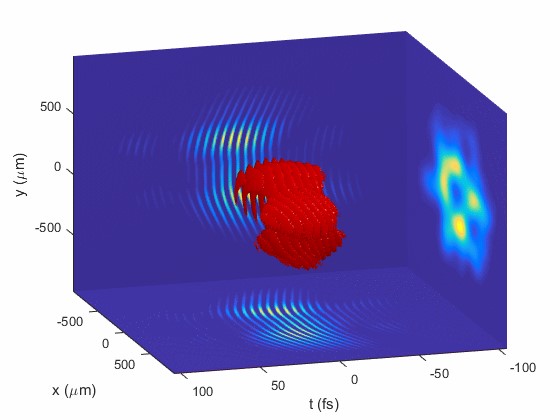
Movie of the E-field of the BELLA beam in (x,y,t) as the beam travels across the best focus.
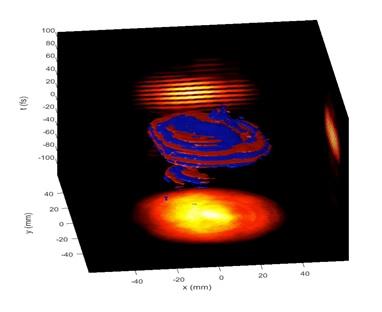
3D view of the E-field of the UHI100 laser beam in a given propagation plane (collimated beam)
References :
“Space-time characterization of ultra-intense femtosecond laser beams”, G. Pariente, V. Gallet, A.Borot, O. Gobert and F. Quéré, Nat. Photonics (2016) 10 p547
“Spatio-spectral metrology at focus of ultrashort lasers: a phase retrieval approach”, A. Borot and F. Quéré, Optics Express (2018) 26 p.26444
Interpretation/design of experiments performed in the PHI group require theoretical modeling supported by challenging 3D Particle-In-Cell (PIC) simulations of laser-plasma interactions. These 3D simulations are paramount for building analytical models of important physical processes as well as obtaining quantitative estimates of the properties of the light/particle sources produced by the novel schemes developed in our group.
Up to now, 3D simulations of plasma mirror sources could not be performed with standard PIC codes as these induce unphysical errors degrading harmonic and electron properties even at very high numerical resolution. We recently demonstrated with LBNL that mitigation of these errors requires huge resource-to-solution that has prevented for a long time accurate 3D modeling even on the largest supercomputers. This has strongly limited the design of applications based on plasma mirror sources. In this context, we recently developed (in collaboration with LBNL) the highly-accurate and massively parallel pseudo-spectral PIC code PICSAR (‘Particle-In-Cell Scalable Application Ressource’) that employs novel massively parallel pseudo-spectral Maxwell solvers to suppress unphysical errors. This code significantly reduces resource-to-solution required to achieve a given accuracy and enabled the very first 3D accurate simulations of plasma mirror sources on large supercomputers as required by our activities. These 3D simulations already enabled a fine understanding of recent 100TW PM experiments at CEA previously out of reach of standard 3D codes. PICSAR has also been highly optimized on exascale architectures that will be required for the most challenging 3D simulations to come.
The 3D simulations run in support of experiments require huge computational ressources. As PICSAR is one of the workhorses of exascale programs/design centers, we regularly obtain 100 million CPU hours a year on petascale clusters/exascale testbeds (e.g. through the INCITE call for proposals) that are key to the success of our theoretical activities.
PICSAR can be run as a standalone code, or as a library called by another PIC code. At present, It notably enhances capabilities of major PIC codes in US (Warp,WarpX) and in Europe (SMILEI). In this regard, PICSAR has been coupled (through the python layer) to the open source code Warp that can now call PICSAR routines for performing the core and most time-consuming parts of the PIC loop. This coupling significantly boosted Warp by a x8 speed-up and enabled its use on modern architectures. "

Snapshot of the electron distribution phase space taken from PICSAR simulations (position z/momentum pz) of a dense plasma irradiated by a high power laser (I>1019W.cm-2). The color scale corresponds to the initial electron position before arrival of the laser. This image is a perfect illustration of the so-called ‘stretching and folding’ mechanism responsible for the emergence of chaos in the laser-plasma interactions at these intensities. The electrons chaotic behavior eventually leads to significant absorption of laser energy in the plasma by stochastic heating.
We study plasmonic excitations in structured targets and their impact on laser-target coupling in a regime of high short pulse laser fields (~30fs) at irradiation intensities (1019-20 W/cm2) several orders of magnitude higher than the typical values used in ordinary plasmonics and such that nonlinear and relativistic effects play a major role. We aim at tuning the features of the SPW driven electron bunches in order to build and validate an ultra-short synchronized light and electron source, with potential applications in probing ultrafast electronic processes in systems of interest in chemistry, biology and material science
The theory of SPW excitation and resonance is well known only in the linear regime and most experiments so far have been restricted to intensities below 1016 W/cm2, unable to drive relativistic SPW because of the intense prepulses inherent to high-power laser systems which can lead to an early disruption of the necessary target structuring. Nonetheless, exploiting the ultra-high contrast 100 TW laser facility UHI100 in Saclay we recently observed, for the first time at our knowledge, the acceleration of an electron beam driven by SPW along the target surface (figure 1) and a strong enhancement of both the energy and the number of electrons emitted from gratings irradiated at an incidence angle close to the resonant value for SPW excitation when compared to flat targets (figure 2). High current (more than 600 pC) electron emission is concentrated in a narrow cone close to the target surface, with energy spectra peaking at 5-8 MeV and reaching up to ~20 MeV that we succeeded to reproduce with massively parallel 2D and 3D numerical simulations (fig. 2 in joint document). Building on this, our last year experimental activity was devoted to clear away most experimental bottlenecks concerning future characterization (i.e. bunch duration determination) and application devoted (i.e. SPW driven high order harmonics emission) experiments.
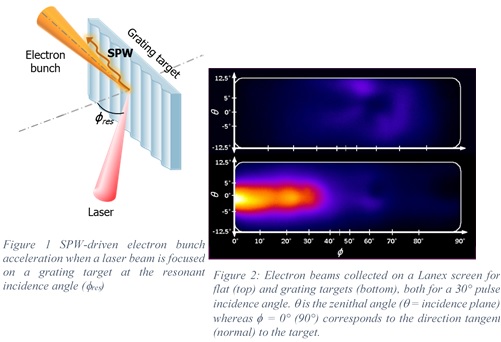
References :
Cantono, G.; Sgattoni, A.; Fedeli, L.; et al. Extensive study of electron acceleration by relativistic surface plasmons PHYSICS OF PLASMAS, 25, 031907 (2018)
Sgattoni, A.; Fedeli, L.; Cantono, G.; et al. High field plasmonics and laser-plasma acceleration in solid targets PLASMA PHYSICS AND CONTROLLED FUSION, 58, 014004 (2016)
Fedeli, L.; Sgattoni, A.; Cantono, G.; et al. Electron Acceleration by Relativistic Surface Plasmons in Laser-Grating Interaction PHYSICAL REVIEW LETTERS, 116, 015001 (2016)
Ceccotti, T.; Floquet, V.; Sgattoni, A.; et al. Evidence of Resonant Surface-Wave Excitation in the Relativistic Regime through Measurements of Proton Acceleration from Grating Targets PHYSICAL REVIEW LETTERS, 111, 185001 (2013)
The team performs various experiments at LIDYL, with UHI100 laser (100 TW-25 fs-10 Hz, commercial system of the company Amplitude Technologies, acquired in 2009 to replace the UHI10 laser), coupled with two radioprotected and fully equipped experimental areas (double plasma mirror chamber, wavefront correction system, experimental chambers, optical diagnostic tools and diagnostics for secondary emissions of plasmas (particles, photons)). This facility will be moved to new location at the end of 2019. Experimental devices (excluding laser) will be installed in a radio-protected room of 200 m2, currently under refurbishment.
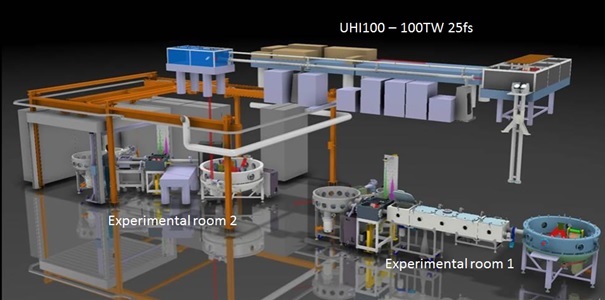
Experimental ensemble is accessible to external teams through various calls:
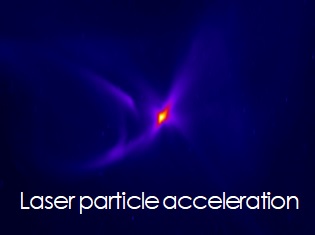
The PHI team is involved in research on :
|
accelerated from interaction of ultra-intense laser pulses with solid targets |
Numerical simulation activities aim at supporting the experiments on High-order Harmonic Generation (HHG), carried out by the Attophysics Group on the AttoLab laser facility. To this end, we develop numerical tools describing the non-linear response of a dilute medium to a strong laser field, on the two spatio-temporal scales of the problem: the microscopic scale, accounting for the interaction of a single atom with the local field, and the macroscopic one, describing the interaction between the laser beam and the target. The microscopic response, i.e. the dipole, is given by the solution of the time-dependent Schrödinger equation, while the macroscopic response is calculated using the wave equation, with the microscopic dipole as a source term.
Molecular imaging with a sub-femtosecond resolution is made possible by the built-in attosecond rescattering dynamics leading to single ionization and elastic rescattered photoelectron as well as double and multiple ionization from inelastic recollision. The experimental diagnostics are aimed at measuring the ion and electron angle-resolved energy spectra in aligned molecules in order to extract the observables from both elastic and inelastic scattering i.e. electron-ion elastic collision cross sections, double ionization yields from inelastic rescattering and the associated electron correlated dynamics, and finally fragment momenta correlations from Coulomb explosion.
Spectroscopy of molecular complexes
Infrared spectroscopy of a molecular complex hosted in a helium droplet makes possible to explore the structure of a complexe as well as its interaction with an environment. The Goutellium experimental setup carry out this type of study with two highly interconnected goals:
- The study of the van-der-Waals complex structure, in collaboration with the SBM Research Group.
- The study of the dynamical effects induced by the interaction with finite-size bosonic fluid (the helium droplet) on the deformations of a very flexible molecular system that is hosted there.
The helium droplet is described as a superfluid medium, except when in contact with a molecular potential which induces its a partial structuration. Our Group is one of the very few in the world to address this issue. It conbines both experimental and numerical approches.
The emergence of new lasers and the introduction of new technologies in the laboratory are opportunity to develop optics, instrumentation and signal processing in order to maintain our state-of-the-art tools and devices. We do not forget the possibilities of valuing these developments. We are particularly interested in developments in:
- optics: fs puse tunability - development of achromatic doubling coupled with a NOPA on the LUCA laser server (O. Gobert group PHI) allowing the tunability of the pump in time-resolved experiments
- Instrumentation: study of transient supersonic jet / effusive jet
- Signal Processing: decomposition of a sequance of photoelectron spectra in collaboration with the ICUBE/IMAGeS Group
Furthermore, we develop the LV_pBASEX Abel image inversion software and distribute licenses to research groups around the world.
The photo-reactivity of molecules and complexes is studied by 2 approaches:
Action spectroscopy
The photo-induced dynamic of molecules or van-der-Waals complexes in the UV-visible photon energy range is studied on EDELWEISS and CICR experimental setups. These are experiments of spectroscopy where the reaction products are identified either by the scattered fluorescence (continuous laser excitation, CICR setup) or by photoelectron spectroscopy (excitation by ns lasers, REMPI ionization, EDELWEISS setup). These experimental setups provides insight on action spectroscopy for the excitation of species which are well characterized, as a function of the stoichiometry. These studies were carried out on:
Ion Pairs
Ion pairs are ubiquitous in Nature, from sea water and aerosols, to living organisms. Being the very first step of crystallization of ionic species and influencing the properties of ion-concentrated solutions or ionic liquids, they also play a key role in countless applications. Although they are met in many areas of Physics, Chemistry and Biology, their characterization is complicated by the co-existence of several types of pairs and their elusive nature in solution.
In this context, this project aims at documenting net neutral ion pairs by investigating them in the gas phase using IR and UV laser spectroscopic techniques which enable us to characterize each type of ion pair individually. This experimental approach is combined with theoretical approaches aiming at identifiying the ion pairs formed in the gas phase, and extrapolating their vibrational signature in solution. Several questions are investigated by this project:
- the gas phase structure of model ion pairs.
- the application of gas phase results to ion pair issues in solution.
- the investigation of Stark effects in isolated ion pairs.
This project is funded by:
- The French National Research Agency (2016-2020, JCJC grant ANR-16-CE29-0017)
- Synchrotron SOLEIL (2019-2020)
- The French National Computing Centers (2016-present, High Performance Computing resources, project A0050807524)
- The Japan Society for the Promotion of Science (2018, JSPS Summer Grant, J. Donon)
- Université Paris-Saclay (2014-2017, PhD grant of the Chemical Sciences Doctoral School of Université Paris-Saclay )
- LabEx PALM (2014-2018, Master student grants, ANR-10-LABX-0039-PALM)
Collaborations:
- Pr. David J. Aitken (Institut de Chimie Moléculaire et des Matériaux d'Orsay, Université Paris-Saclay)
- Dr. Denis Céolin (Soleil Synchrotron Facility, France)
- Pr. Masaaki Fujii, Dr. Shun-ichi Ishiuchi (Tokyo Institute of Technology, Japan)
Références:
J. Donon, PhD thesis Université Paris-Saclay (2020)
J. Donon, S. Habka, V. Vaquero-Vara, V. Brenner, M. Mons, E. Gloaguen J. Phys. Chem. Lett. (2019)
S. Habka, T. Very, J. Donon, V. Vaquero-Vara, B. Tardivel, F. Charnay-Pouget, M. Mons, D.J. Aitken, V. Brenner, E. Gloaguen, Phys. Chem. Chem. Phys. 21 12798 (2019)
S. Habka, PhD thesis Université Paris-Saclay (2017)
S. Habka, V. Brenner, M. Mons, E. Gloaguen J. Phys. Chem. Lett. (2016)
Environments opens intermolecular relaxation channels. The goal of this study is to investigate the competition between intermolecular and intramolecular relaxation processes. It goes through the study of atoms, Rydberg molecules, etc...
In the framework of research on clean, secure and efficient energy, hydrogen production by solar water splitting is a very promising method. Overall efficiency of a solar water splitting process is directly related to local photo-electro-chemical reactions at the photo-electrodes-electrolyte interfaces that depend on the local environment defined by its morphology, chemical composition and electronic structure.
Since few years, we are interested by the hydrogen production by water splitting using oxide semiconductors as photo-anodes. Aqueous chemical growth (ACG) is used at SPEC / LNO to deposit nanostructured oxide films with thicknesses from tens to several hundreds of nm, it is more versatile and more appropriate for larger scale production.












